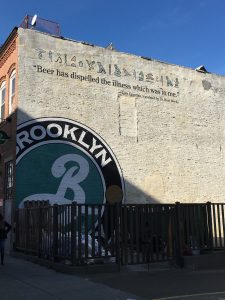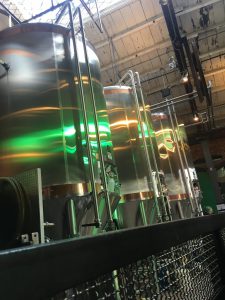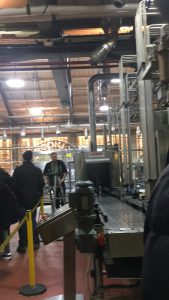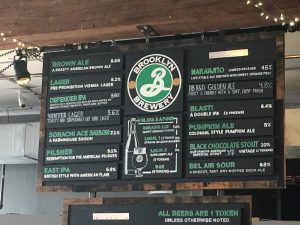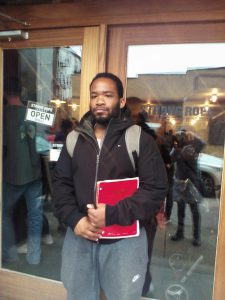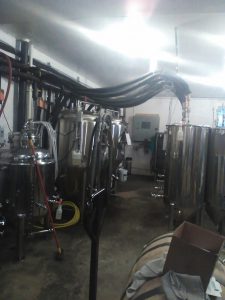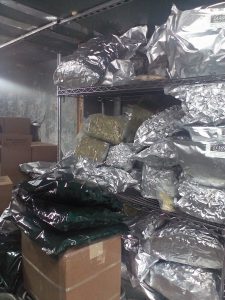I went to the Circa Brewery at 152 Lawrence Street in Brooklyn about 11:30am. When I arrived I began taking pictures of the place, and this must have made the people slightly nervous.
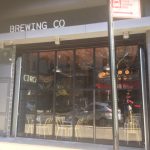
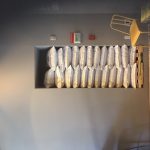 Then a nice young lady named Mia approached me with a smile on her face, then I explained, I was from Citytech and I needed some information, then asked if she’d help me. She acquiesced as I asked her to let me take a few more pictures then we could get started. That was fine with her so we began. I asked her ” is this a Brewery, a roasting house for coffee”? She said “no, this is a brewery for beer.” My ship had sunk. Again I thought myself as being so dense, obtuse.
Then a nice young lady named Mia approached me with a smile on her face, then I explained, I was from Citytech and I needed some information, then asked if she’d help me. She acquiesced as I asked her to let me take a few more pictures then we could get started. That was fine with her so we began. I asked her ” is this a Brewery, a roasting house for coffee”? She said “no, this is a brewery for beer.” My ship had sunk. Again I thought myself as being so dense, obtuse.
I looked on in bewilderment and followed through. “Okay, well. This is a Beer Brewery, I’m here and I need a paper to write.” I said “okay then we’ll make it about the beer making  procedure.” I asked a few more questions and Mia relented and thought her co-worker might be a better choice to explain the processes. Danny was elevated on some stairs when I first saw Mia talk to him. She
procedure.” I asked a few more questions and Mia relented and thought her co-worker might be a better choice to explain the processes. Danny was elevated on some stairs when I first saw Mia talk to him. She 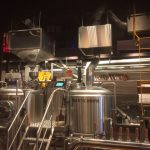 came back to me and said her co-worker would be over to help me in a moment. Danny, a medium build dark haired man came over and introduced himself. I explained to him that I was from NYCCT on Jay Street and I had to write a paper, would he give me some information. He agreed, then I explained to him I would be as brief as possible, as not to take him away from his work for too long. I think he liked that, but was also willing to help me.
came back to me and said her co-worker would be over to help me in a moment. Danny, a medium build dark haired man came over and introduced himself. I explained to him that I was from NYCCT on Jay Street and I had to write a paper, would he give me some information. He agreed, then I explained to him I would be as brief as possible, as not to take him away from his work for too long. I think he liked that, but was also willing to help me.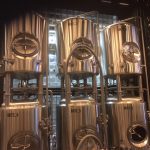
Danny has been working as a brew master expert for 8 years. The first question was what were the ingredients that were used in the beer making process. He told me that barley is the primary ingredient. The best barley comes from Germany. He mentioned that used a hybrid English, step mash with grain (barley), some Oat, Wheat, Malt etc.… The other ingredients are added for color and flavor. He explained that he took the Wort (Wheat liquid) which contained the starch and sugar, boiled it for 60-90 minutes, then cooled it rapidly. This is called the pitch. Then they add the yeast, then it goes to the yeast fermenter. The yeast eats the sugar and produces alcohol and CO₂. Next it is then cooled for clarity.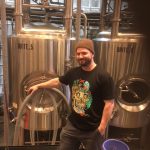
Once it is deemed fit to serve or done, it is transferred to the bright beer tank. Then the Malt (color), barley, hops and water fixes the flavor. Danny explained that the best barley come from the farmer, who sells it to the
Maltster, who sells it to the brewer. The ingredients are sometimes roasted or mixed with other grains or oats to give it a distinct flavor. There is Pilsner, Lager and Stouts. All of which requires a different method of fermentation. Danny says that the Pilsner beer he makes is exceptional. They only make about 750 gallons 2-3 times a week. It is not a lot in comparison to the larger breweries, but they hold their own in this part of Brooklyn. Located at 152 Lawrence Street, Brooklyn, New York 11201
Being at the Brewery brought back a spate of memories to when my Dad tried to make his own home brew. He had bought some grains and placed them in a contraption he’d made by welding some brass fittings together and applied heat to it. Though he tried his best to imitate the Beers of his time, it was a flop. Making beer should be left up to the pros, its a craft with many well kept secrets.

